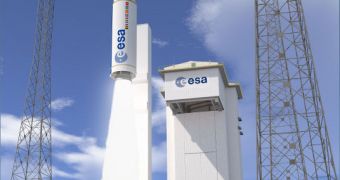Officials at the European Space Agency (ESA) announce that the first Vega delivery system is now ready for launch. The rocket finished its final checkout at the Kourou Spaceport, in French Guiana, South America, on Friday, January 13.
Its maiden flight – dubbed VV01 – is currently scheduled to occur on February 9. If the mission is successful, then ESA would have succeeded in its efforts to complete its launch capabilities with a light-lift delivery system.
Its arsenal of rockets also include the Ariane V heavy-lift rocket developed by Arianespace and the Soyuz medium-lift booster, which is obtained under a long-term contract with the Russian Federal Space Agency (RosCosmos).
Vega will therefore fill a gap in launch capabilities that will enable ESA to launch smaller missions to Earth's orbit at a lower cost than currently possible with Ariane 5. In other words, the agency will tap yet another market, that of companies seeking to launch small satellites to space.
The first Vega to take off from Kourou began its assembly process in November 2010, when its P80 first stage was installed at its dedicated launch pad. The second and third stages, both containing solid propellant, were added later on, followed by the Attitude & Vernier Upper Module.
The AVUM acts as a fourth stage and contains liquid propellant. After integration, the four stages were put through a number of tests, meant to assess the performances of systems including those controlling avionics, guidance, telemetry, propulsion, separation pyrotechnics and safety.
The final test – the synthesis control check – was carried out on January 13, and all systems performed within nominal values. ESA engineers even pressurized the AVUM, just like they would before an actual launch.
All that remains to be done now is to integrate both the payload fairing and the payload itself – collectively known as the upper composite – onto the four stages. Launch will occur as soon as a final checkout and a wet countdown rehearsal are completed.
On its first flight, the VEGA rocket will carry LARES and ALMASat-1, spacecraft belonging to the Italian Space Agency, as well as seven CubeSat-class satellites, developed by various universities in Europe.

 14 DAY TRIAL //
14 DAY TRIAL //